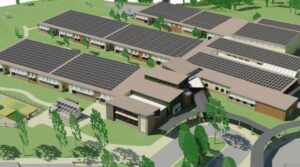Green Built Alliance’s Appalachian Offsets local carbon-offsetting program has begun work on its first community improvement projects since its relaunch last fall, including fundraising for a solar system for the new Isaac Dickson Elementary School and completing an energy-efficiency upgrade at Opportunity House.
Appalachian Offsets is a voluntary carbon offset program that offers businesses, organizations, and individuals the option to easily reduce or offset their carbon footprint. Supporters offset their emissions by paying into a community fund that helps make energy-efficiency improvements for local nonprofits, schools and low-income housing.
Appalachian Offsets’ largest undertaking to date, the Isaac Dickson Elementary School project will install a $1.1 million solar system on the roof. The LEED Platinum-certified school was designed as one of the state’s first Net-Zero Energy schools and has been awaiting the integral solar system since building construction completed in 2016.

“Installing a rooftop solar system on the new Isaac Dickson Elementary will fulfill the architects’ vision of using the school building itself as learning tool that can be used to facilitate discussions about our environment and conservation, as well as the impacts of fossil fuel consumption not just on our climate but also on our air and water quality,” Isaac Dickson Elementary PTO Co-President Matt Menne said.
“Our kids will bear a much greater burden of the consequences of climate change caused by carbon emissions than their parents, so we owe it to them to do whatever we can to ensure that these youngest members of society have the same opportunities to succeed in life that we have had,” said Menne, who is also a climate scientist at the National Oceanic and Atmospheric Administration. “What better way to help than by reducing the carbon footprint of our schools, which provides the added benefit of saving money on energy costs for the district in the long run.”
Over its 30-year life, the system is expected to save $3.5 million in energy costs for the school.
Private investors will cover the majority of up-front costs for the new solar system, and Appalachian Offsets has taken on the challenge of raising the remaining $220,000. Thanks to the generosity of an anonymous donor, the project secured a matching grant of $110,000 in early summer of 2017, leaving a balance of $110,000 needed in community contributions to complete funding..
“If the community raises the $110,000, the school is essentially getting a million-dollar system for free that will deliver millions of dollars of benefits over its life,” said Dave Hollister, president and CEO of Sundance Power Systems. “It’s a win for the community, the school, the environment and the investors.”
The system will be installed by Sundance, which won the bid from Isaac Dickson based in part on their unique proposal of this public-private partnership with investors helping to bring the plan to fruition.
“In my mind, there’s a huge educational value too,” Hollister said. “Isaac Dickson would be one of the first net-zero energy schools in the southeast, and this would be a way for students to really see that solar works and their school is running on solar. That’s a paradigm shift, which is really important from a developmental standpoint in creating a consciousness of sustainability.”
Another Appalachian Offsets project, an energy-efficiency upgrade at the nonprofit Opportunity House in Hendersonville, was completed the first week of April. The LED lighting upgrade will save more than $10,000 per year in energy costs for the organization and reduce its carbon footprint by 47 metric tons annually. Also supported by incentives from Duke Energy’s Small Business Energy Saver program, this $26,000 LED project has a 187-percent return on investment.
Initially launched in 2005, Appalachian Offsets completed numerous energy-efficiency retrofits for local nonprofits in the following two years. Interest in the program waned with the onset of the 2008 recession, as building projects were delayed or cancelled and businesses lacked the resources to offset their emissions. However, today, environmental stewardship and the economy are once again growing in Western North Carolina, and Appalachian Offsets was officially relaunched in fall of 2016 in response to community demand.
There is no shortage of future projects for Appalachian Offsets to undertake as funding becomes available based on community support of the program. Appalachian Offsets’ program administrators are collaborating with organizations including The Land of Sky Regional Council Waste Reduction Partners and Lime Energy, which have identified numerous projects that are ready and waiting for Appalachian Offsets’ support.
“Appalachian Offsets is the bridge that matches companies and individuals looking to offset their emissions with organizations who need support cutting energy cost and upgrading their facilities,” said Green Built Alliance Executive Director Sam Ruark-Eastes. “The program encourages all of us to reduce our carbon emissions first, then pay into a fund that collectively helps others do the same.”
Individuals and businesses interested in getting involved can visit www.cutmycarbon.org to calculate their carbon footprint and offset emissions, as well as learn more about the projects that will be supported by contributions to the community fund.
Cari Barcas is community engagement director at Green Built Alliance. She has more than a decade of experience in communications and nonprofit management, including time reporting on the green building scene in Chicago as a journalist covering residential and commercial real estate. Connect with Cari at Cari@greenbuilt.org.
You can also view this article as it was originally published on page 38 of the 2017-18 edition of the directory.

